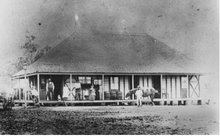Maybe it was the chilling effect of the cemetery, sitting in a cold hall for nearly 2 hours on Monday night or a reaction to frantic busyness, but colds and flu have engulfed my household. It seems to be the kind of illness that turns the brain to mush (unless that is the encroachment of age.) Writing and research have been low on my list with staying upright being the overwhelming priority.
One thing I have been doing is leafing through my borrowed collection of family histories looking at accounts of shipboard life. There is very little information about what life on board ship was actually like so one has to extrapolate from newspaper accounts. One family history does mention a broken mast and the ship drifting backwards for days before a new mast could be installed. Others mention shipboard illnesses.
According to the Brisbane Courier of January 22, 1873, the Lammershagen has in steerage “a clear width of 17 feet [5 metres] between the rows of bunks, and the between decks has a clear height of 7 feet 8 inches [2.2 metres]. This, we think equals the steerage passenger accommodation of the majority of immigrant vessels of this size trading to Queensland.”
This account makes the space allotted in steerage to be almost pleasant but a description of ships bound for South Australia published by the South Australian Maritime Museum suggests otherwise.
“The horror and or amazement of most to find that their world for at least the next three to four months was to comprise the area of the number of bunks allowed their family and a space at a rough trestle table along the centre of the quarters, is impossible to convey in print. The total area comprised the bunks and a few feet of space alongside one side of the bunks and the space under the lower berth - about as much as is allowed these days in economy class sleeping berths on long distance trains! Here the migrant family was to exist on a voyage expected to take at best about 100 days! The suggestion is completely beyond the comprehension of most present day travellers.”
An interesting source I found on the web contains diaries of migrants bound for New Zealand between 1842 and 1892. From the accounts I read, shipboard life seemed to consist mainly of sea-sickness, arguments between passengers, discussion of food and the occasional sighting of other ships or of interesting marine life. I plan to read more of these online accounts to help me build up a picture of everyday life on board ship.
Subscribe to:
Post Comments (Atom)

No comments:
Post a Comment